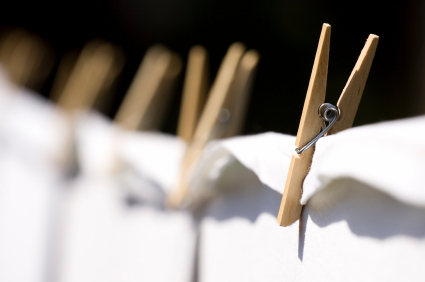One thing most of us rely on is our washing machine and dryer. During emergencies where the power grid is affected, it is important to know how to know basic off-grid strategies to manage your everyday home duties. This was highlighted in the preparedness manual, The Prepper’s Blueprint as a must-know skill. So how do you do your laundry if there’s no power?
Four loads of laundry per week is normally what we do for our family of four people. We also do sheets every week and blankets once a month. So what would happen if the power goes out, especially in the winter. It’s not like you could wash your clothes in the frozen lake, right? And if you can, more power to you, but most of us will need to have a plan in place if there’s a long-term (month-long or longer) power outage or grid failure. So why not look at what those who live off-grid already do?
Washtub & Wringer
A galvanized washtub and wringer are a great option for your off-grid laundry. This is the most practical way for preppers to do their laundry by hand off-grid in large quantities. Plain and simply, this is just an old-fashioned washer and wringer. For around $240 you can grab a galvanized tub that will include 2 sturdy galvanized laundry sinks with drain and double stand. Next, you’ll to affix to it a laundry wringer, such as the Calliger Hand Crank Clothes Wringer. It will run you around $140 but will be worth its weight and cost if the power goes out and you need it. Wringing wet laundry by hand can be quite tiring and hard on your hands and wrists. This solution is perfect for emergency preparedness and natural disasters, or for people who simply love the idea of self-sufficient, off-the-grid living. This useful wringer will help you effortlessly remove the water from your clothes speed up the drying time of laundry.
Non-Electric Washing
As demonstrated in the above video, a wringer/washer combo can be effective at getting clothes clean too. What is shown is a Lehman’s washer and wringer, but it will cost you $899.00. Another popular and much cheaper option is the Wonder Wash or the Avalon Bay Eco Wash. Both have good reviews on Amazon. The Wonder Wash will cost you about $50.00 and the Avalon Bay Eco Wash will cost you about $53.00. These are hand-powered washers, but they can really be hard on you if you aren’t used to them. With these hand-cranked washing machine options, be prepared for an upper-body workout!
Bucket & Brush
Basically, you grab a bucket and a brush and scrub your clothes clean. This is an inexpensive way to clean clothes especially if you don’t have access to any of the other options already listed. If you choose to wash your clothes using a bucket, a washboard can come in handy, but a brush is cheaper and can work just as well. If you try this method, try using a second bucket full of clean water you can rinse the clothes off with and use your hands to squeeze the clothes out. Wringing by hand can stretch them out. Only use the brush on the dirtiest sections of your clothes in order to keep them in good shape for longer.
Once you’ve figured out how to wash your clothes, you’ll need to dry them. If you live in an arid environment, drying them outside in summer is a good idea. You can also dry them indoors in colder climates. This works really well if you have a wood-burning stove in your home. Since those foster a dryer climate, it can be productive to simply hang your clothes around the house and let them dry. I do this year-round because it’s so dry where we live that the extra added humidity is desperately needed inside.
If you choose to dry clothes outside, dry them inside out to avoid the fading from the sun’s rays. Also, take notice when hanging clothes. Wet clothing is heavier and that weight can drag down and stretch our clothes. Avoid clothes pins only attached at the shoulders of shirts. Instead, try to lay items flatter. You could also drape your clothes over the line.
This article was originally published at Ready Nutrition™ on March 9th, 2021








where can I buy a washer like the one in the video, I live in Ireland so even a set of drawing’s would do
A regular mop bucket wringer would work well to squeez water from clothes before hanging them to dry